File Compression
Archiving & Compression
The two processes go hand in hand but are not the same.
Archives:
- store rarely used information and preserve it
- files are stored as a single file
- archiving makes the data more portable and can serve as a backup in case of loss or corruption
Compression:
- reduces file size by reducing redundancy
- preserve storage space
- speeds up data transfer
- reduces bandwidth load
Let’s look at a file directory of notes you’ve been taking:
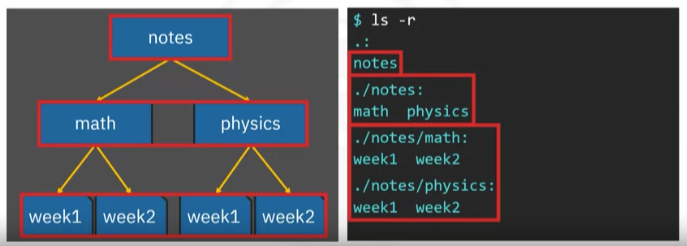
tar - create archive
tar can be used for many operations we’ll start with creating an archive. It can be used to archive and extract files
A popular term is “tar ball”, To archive the notes directory
-c -forcf-cto create a new tar archive file-ftells tar to interpret its input from the file rather than from the default which is standard input
tar -cf <newfile.tar> <directory to archive >

If you would also like your archive to be compressed, you can
- enter the same command, except now you include the “-z” option, which
- filters the archive file through a GNU (pr. “geh-noo”) compression program called g-zip.
- Adding the suffix “dot g z” to the output name, ensures that Windows-based programs, for example, will correctly recognize the file type.
- See create gz file section below
tar -czf <newfile.tar.gz> < directory to archive&compress>
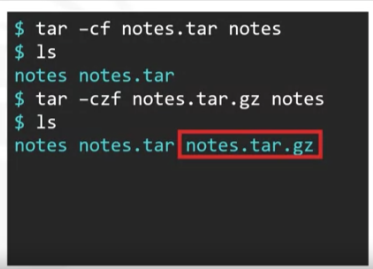
| File type | Description |
|---|---|
| .tar | uncompressed archive file |
| .zip | (usually) compressed archive file |
| .gz | file (archive or not) compressed using gzip |
Tar supports a vast range of compression programs such as
gzipbzip2lziplzmalzopxzandcompress- When creating compressed tar archives, it is an accepted convention to append the compressor suffix to the archive file name. For example, if an archive has been compressed with
gzip, it should be named archive.tar.gz. -c -forcf-cto create a new tar archive file-ftells tar to interpret its input from the file rather than from the default which is standard input
-vwill display the files being processed
# ___ Create an archive named archive.tar from file1 file2
tar cf archive.tar file1 file2
# ___ Create a file backup.tar of the /home/user directory
tar -cf backup.tar /home/usertar- create gz archive
Gzip is the most popular algorithm for compressing tar files. When compressing tar archives with gzip, the archive name should end with either tar.gz or tgz.
-ztells tar to compress using the gzip algorithm-jtells tar to use the gzip2 algorithm and creates a .bz2 archive file
# ___ Create a tar.gz file
tar cfz archive.tar.gz file1 file2 file3...
# ___ Create a tar.bz2 file
tar cfj archive.tar.bz2 file1 file2 file3...list tar ball files
- From the notes example above, if we want to make sure all the files were compressed and archived we can use
-tfwill list all the files and directories in your tar balltar -tf <newfile.tar>
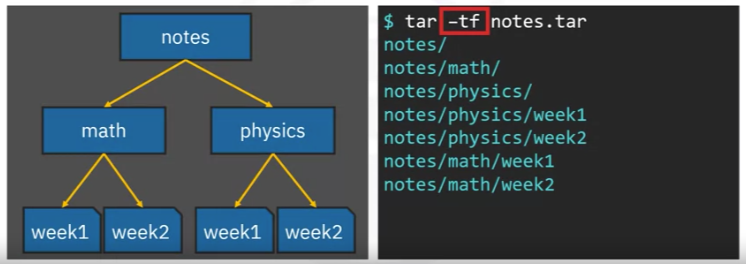
tar to list
When used with the list
-toption the tar command will list the content of a tar archive without extracting it
- -t list content of archive file
- -v to list file owner, size, timestamp
- DOES NOT EXTRACT
# ___ List the content and information of an archived file without extracting
tar tvf archive.tartar to extract
To extract a tar or tar.gz format file use tar with the options below. By default it will extract the contents to the current working directory.
-xfused to extract an archive file- xfis used for tar.gz or tar.bz2 files with a destination folder as shown belowtar -xf <file to extract> <filename to extract to>-xvfto print names of files that are being extracted-cextract to a specified directory
# ___ List and EXTRACT files from an archived file
tar xvf archive.tar
# ___ Extract the archive file contents to the opt/files directory
tar xf archive.tar -c /opt/files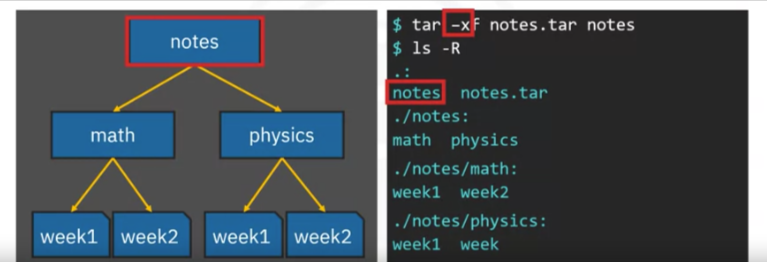
tar Decompress & Extract
# ___ Decompress and Extract
tar -xzf notes.tar.gz newfilename
ls -R
tar extract specific files
To extract a specific file(s) from a tar archive, append a space-separated list of file names to be extracted after the archive name
# ___ Extract specific files from archive file
tar xf archive.tar file1 file2tar extract with wildcard
To extract files from an archive based on a wildcard pattern, use the
--wildcardsswitch and quote the pattern to prevent the shell from interpreting it.
# ___ Extract files ending in .js
tar xf archive.tar - - wildcards '*.js'tar add files
To add files to an existing tar archive use
-r
# ___ Add new file to archive -v to display the name of files
tar rvf archive.tar newfiletar remove files
Use - - delete to remove files from an archive
# ___ Remove file1 from archive
tar - -delete -f archive.tar file1| Command | Description |
|---|---|
tar cf my_dir.tar my_dir |
Create an uncompressed tar archive |
tar cfz my_dir.tar my_dir |
Create a tar archive with gzip compression |
gzip file |
Compress a file with gzip compression |
tar xf file |
Extract the contents of any type of tar archive |
gunzip file.gz |
Decompress a file that has gzip compression |
Zip
Zip compresses files prior to bundling them, while tar with -z bundles then compresses
To compress a directory and package it to a zip file use: zip -r <new filename.zip> <directory to compress>
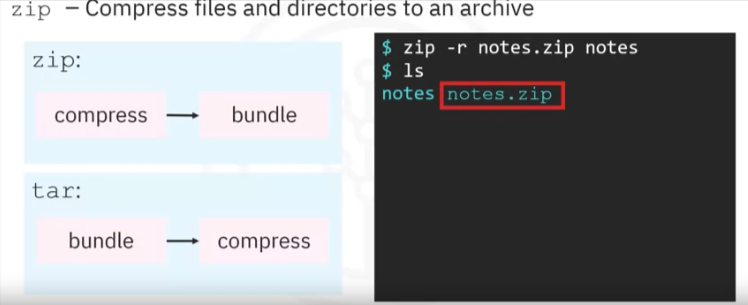
Unzip
Extracts and decompresses zipped archive files
Syntax: unzip <zipped filename.zip>
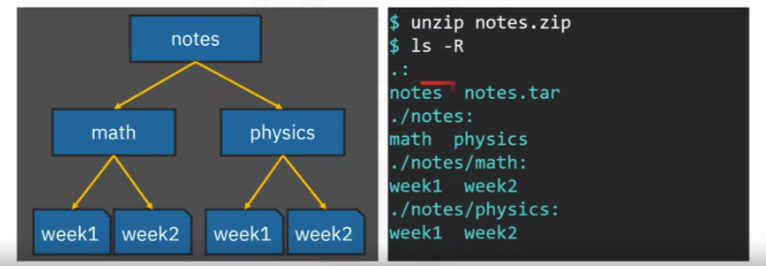
Unzip to Directory
If we want to specify where to unzip the zipped file we need to use
-dwhich specifies the target directoryThis will create a new directory named employeesdb and extracts all files to it
~$ unzip $dir_path/employeesdb.zip -d $dir_path # RESPONSE Archive: /mnt/d/data/MySQL/employeesdb.zip creating: /mnt/d/data/MySQL/employeesdb/ creating: /mnt/d/data/MySQL/employeesdb/sakila/ inflating: /mnt/d/data/MySQL/employeesdb/load_salaries2.dump inflating: /mnt/d/data/MySQL/employeesdb/test_versions.sh inflating: /mnt/d/data/MySQL/employeesdb/objects.sql inflating: /mnt/d/data/MySQL/employeesdb/load_salaries3.dump inflating: /mnt/d/data/MySQL/employeesdb/load_dept_emp.dump inflating: /mnt/d/data/MySQL/employeesdb/test_employees_sha.sql inflating: /mnt/d/data/MySQL/employeesdb/Changelog creating: /mnt/d/data/MySQL/employeesdb/images/ inflating: /mnt/d/data/MySQL/employeesdb/employees_partitioned_5.1.sql inflating: /mnt/d/data/MySQL/employeesdb/test_employees_md5.sql inflating: /mnt/d/data/MySQL/employeesdb/README.md inflating: /mnt/d/data/MySQL/employeesdb/employees.sql inflating: /mnt/d/data/MySQL/employeesdb/load_titles.dump inflating: /mnt/d/data/MySQL/employeesdb/employees_partitioned.sql inflating: /mnt/d/data/MySQL/employeesdb/load_dept_manager.dump inflating: /mnt/d/data/MySQL/employeesdb/sql_test.sh inflating: /mnt/d/data/MySQL/employeesdb/load_departments.dump inflating: /mnt/d/data/MySQL/employeesdb/load_salaries1.dump inflating: /mnt/d/data/MySQL/employeesdb/show_elapsed.sql inflating: /mnt/d/data/MySQL/employeesdb/load_employees.dump inflating: /mnt/d/data/MySQL/employeesdb/sakila/README.md inflating: /mnt/d/data/MySQL/employeesdb/sakila/sakila-mv-data.sql inflating: /mnt/d/data/MySQL/employeesdb/sakila/sakila-mv-schema.sql inflating: /mnt/d/data/MySQL/employeesdb/images/employees.jpg inflating: /mnt/d/data/MySQL/employeesdb/images/employees.png inflating: /mnt/d/data/MySQL/employeesdb/images/employees.gif